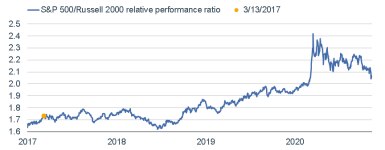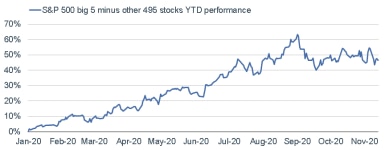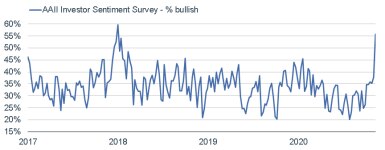Changes: Vaccine News Changing Market’s Leadership Characteristics?

Key Points
Last week saw another massive rotation from “stay-at-home” to “get-out-and-about” stocks; but it was, for now, short-lived.
We have closed out our overweight large cap/underweight small cap tactical recommendation, after a very successful three-and-a-half years.
Euphoria around vaccine news and last week’s market strength is now manifesting itself in both behavioral and attitudinal investor sentiment measures.
This week’s report will look at last week’s market moves in the wake of positive vaccine news (with additional and even better news today); but will also review our most recent tactical recommendation change.
An A and a near-A+ on the vaccine front
Pfizer came out of the gate first last Monday when it announced a 90% effective rate for its COVID-19 vaccine; to be followed up this morning by Moderna’s announcement of an even higher 94.5% effective rate. In both cases, pre-market futures soared on the news; and we can look to last week for details that may be important for investors to consider as we head toward year-end. There was also an election recently—in case you weren’t aware. Of course we did not know the results of the presidential election until the following weekend (and still don’t know what the make-up of the Senate will be); which means it was difficult to parse out the effect of the election and the vaccine news on market behavior last week.
Let’s focus for now on the vaccine news. The analogy I’ve been using since Pfizer’s announcement is that it represents a light at the end of the tunnel. However, given the rampant resurgence in the virus case count, hospitalizations and deaths; we remain in the dark depths of the tunnel. It took eight months between March and October to register nine million cases; while it only took 10 days to get to the 10 millionth case. As good as the vaccine news is—from both Pfizer and Moderna—they are not the perfect elixir for what ails us, either from a health or economic perspective.
Rotation redux
As is typically the case, good macro news works its way into the stock market more quickly than it does into economic statistics. By the time the market opened last Monday, the S&P 500 was up nearly 4% from the prior Friday’s close; although it faded throughout the day. The winners on Monday, which persisted as winners on Tuesday, were decidedly in areas of the market that had been pandemic-era losers. In other words, investors who had a great two days early last week, probably had stellar year-to-date performance; and vice versa.
On Monday alone, the Russell 1000 Value Index outperformed the Russell 1000 Growth Index by nearly 600 basis points—which was a record high for a single day. In addition, according to Ned Davis Research (NDR), S&P 500 stocks with the worst 26-week momentum outperformed those with the best 26-week momentum by 1155 basis points—the most since April 2009 (when the post-financial crisis bull market had just gotten underway). Also from NDR, the S&P 500 Growth Index had outperformed the S&P 500 Value Index by 31.5% for the 12 months ending October 31—a record three-standard deviation event.
We’ve seen these rotations sporadically since early September—from “stay-at-home” to “get-out-and-about” stocks and sectors. Even last week’s huge rotation to the latter on Monday and Tuesday lost its momentum as the week concluded. In the near term, the rotations are likely to continue in fits-and-starts—a tricky environment for investors to navigate. We continue to recommend that investors maintain discipline; especially with regard to periodic rebalancing and diversification (within and among asset classes).
Tactical recommendation change
We are also adjusting a long-held tactical recommendation. Since March 2017, we have been recommending an overweight to large cap stocks (using the S&P 500 as the benchmark) and an offsetting underweight to small cap stocks (using the Russell 2000 as the benchmark). As you can see in the chart below, it’s been a beneficial tactical position.
Large Cap Outperformance Fading
Source: Charles Schwab, Bloomberg, as of 11/13/2020. Indexes are unmanaged, do not incur management fees, costs and expenses and cannot be invested in directly. Past performance does not guarantee future results.
The better relative performance of small caps since the March low for stocks came in fits-and-starts; but only last week finally broke into positive relative strength (vs. large caps) mode from a technical perspective. In fact, the Russell 2000 had its first new closing high in 555 trading days. We would caution investors that the fundamental difference between the two cohorts remains in favor of large caps—including on factors such as debt/equity ratios, profitability, gross margins and the percentage of “zombie” companies. As such, we suggest investors looking for interesting small cap opportunities to continue to screen for the aforementioned quality factors; as we believe they will generally continue to be performance leaders.
At least last week, most of the relative strength within small caps was on the “value” side, as you can see below.
Small Cap Value Won Last Week
Source: Charles Schwab, Bloomberg, as of 11/13/2020. Past performance is no guarantee of future results. Indexes are unmanaged, do not incur management fees, costs and expenses and cannot be invested in directly.
What’s important to understand about that move is that the Russell 2000 Value Index has a nearly 28% weight in financials (the largest financials weight of any major U.S. index). Financials—on which we have an outperform rating—received a big boost last week from the surge in the 10-year yield that accompanied the Pfizer vaccine news. In addition, there is very little energy exposure in the various growth indexes; however, they are between 3-4% in most major value indexes. Looking at last week’s sector performance below, you can see why small cap and value indexes were given a boost from energy (on which we have a market-perform rating) and financials.
Energy and Financials Won Last Week
Source: Charles Schwab, Bloomberg, as of 11/13/2020. Past performance is no guarantee of future results.
Big 5 vs. other 495
One of the manifestations of the sporadic rotations that have been underway since early September, is that the bias in performance is moving away from the “big 5” stocks which had dominated performance until then. As a reminder, the largest five stocks in the S&P 500 by market cap are Apple, Microsoft, Amazon, Google and Facebook. They are often lumped together as tech stocks; but in reality, only the first two are in the tech sector; while Amazon is in the consumer discretionary sector and the other two are in the communication services sector. At the early September peak in the S&P 500, those five stocks represented nearly 25% of the overall index; and had more than a 60 percentage point positive performance spread over the other 495 stocks in the index, as you can see below.
Big 5 Relative Performance Fading
Source: Charles Schwab, Bloomberg, as of 11/13/2020. Past performance is no guarantee of future results.
The chart below continues the look at the relationship between the big 5 and the other 495 over various time periods associated with the pandemic and market cycle. Although not an extreme, since September 2 the big 5 stocks have been underperforming the other 495—clearly a change from the other time frames shown.
Big 5 Ruled Until Early September
Source: Charles Schwab, Bloomberg, as of 11/13/2020. Performance is based on market cap-weighted average of the 5 largest and 495 smallest S&P 500 stocks. Past performance is no guarantee of future results.
Sentiment surge
We continue to expect rotations and bouts of volatility to be driven by the push-and-pull details around the virus’ impact on growth and vaccine news’ impact on psychology. Speaking of psychology, from a market perspective, there may be too much optimism (or complacency). Strategas’ latest institutional investor survey indicated that 68% believe the next 10% move will be higher—a new high for the pandemic era. Inflows into U.S. equity exchange-traded funds (ETFs) have also accelerated recently.
As many regular readers know, I keep an eye on SentimenTrader’s “Smart Money” and “Dumb Money” Confidence measures—which are real-time gauges of what each cohort is doing with their money and shown below. There are no opinions associated with these measures; as such, they are “behavioral” measures of sentiment. The “Smart Money” cohort includes large commercial hedgers, speculators and institutional investors—and generally are considered non-contrarian signals at extremes. The “Dumb Money” cohort includes smaller speculators and traders and generally are considered contrarian signals at extremes. As you can see below, the “Dumb Money has become very optimistically-positioned; while the “Smart Money” has been moving in the opposite extreme. The spread is not quite as extreme as was the case just prior to the start of the February-March bear market; but something on which to keep an eye.
Smart and Dumb Money Diverging Again
Source: Charles Schwab, SentimenTrader, as of 11/13/2020. SentimenTrader's Smart Money Confidence and Dumb Money Confidence Indexes are used to see what the “good” market timers are doing with their money compared to what the “bad” market timers are doing and are presented on a scale of 0% to 100%. When the Smart Money Confidence Index is at 100%, it means that those most correct on market direction are 100% confident of a rising market. When it is at 0%, it means good market timers are 0% confident in a rally. The Dumb Money Confidence Index works in the opposite manner.
Until recently, most attitudinal measures of investor sentiment were not showing commensurate extremes of optimism. But as you can see below, in the past week, we saw a huge jump in the percentage of bullish respondents to the weekly survey done by the American Association of Individual Investors (AAII)—almost hitting the peak that preceded the “volmaggedon” plunge in U.S. stocks in early 2018.
Spike in AAII Bullishness
Source: Charles Schwab, Bloomberg, as of 11/11/2020.
Glass half-full and glass half-empty investors both have something to rest on recently. We believe the push-and-pull of negative virus news and positive virus vaccine news will vie for the market’s attention and is likely to bring more swift rotations and bouts of volatility. We may be heading into a more prolonged period where “get-out-and-about” stocks have their day in the sun; but the near-term could remain choppy.






